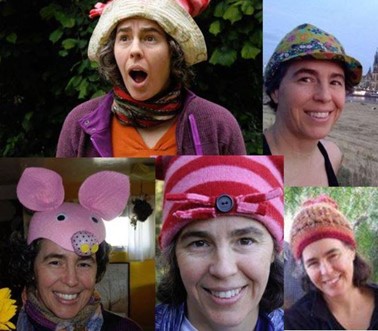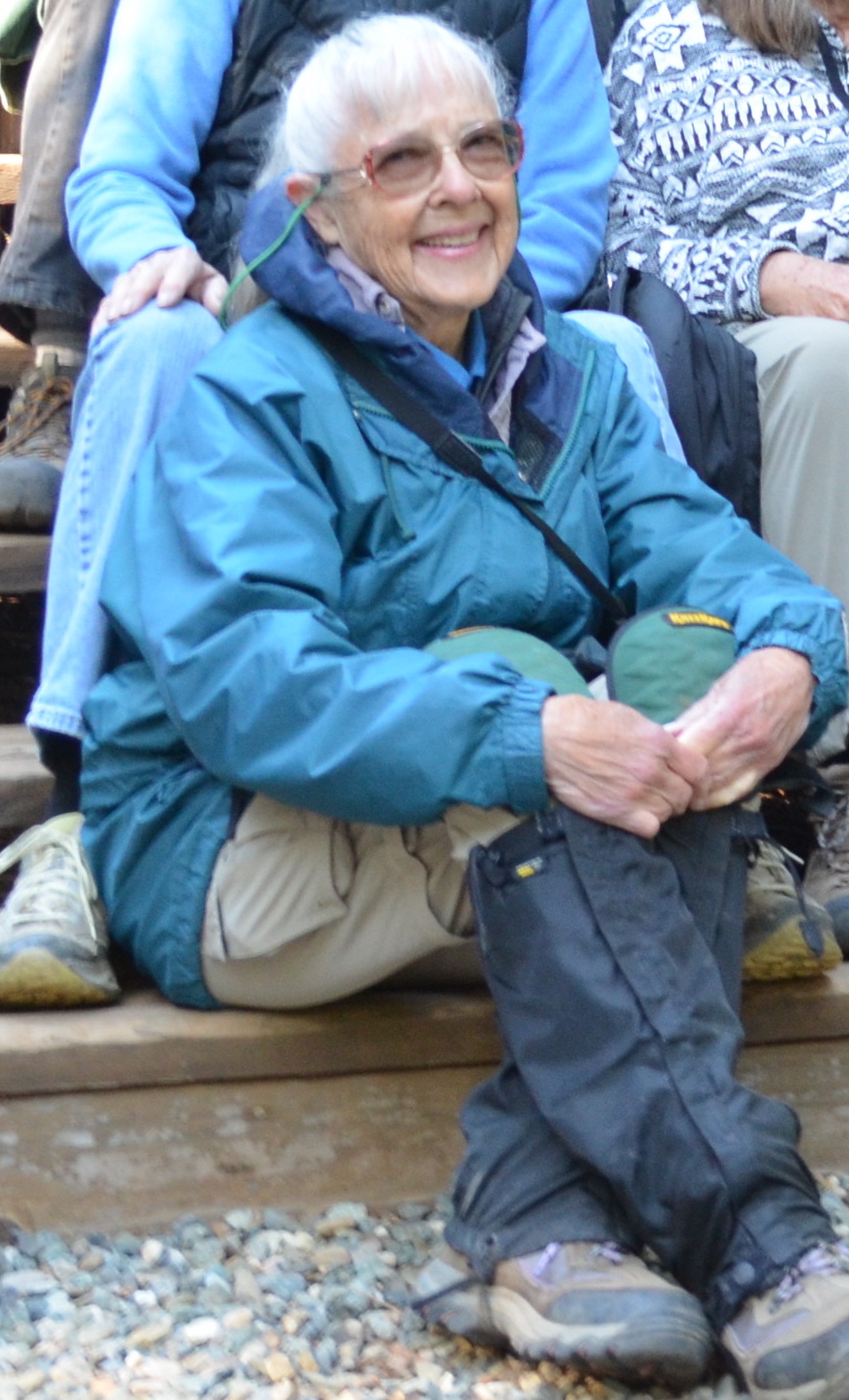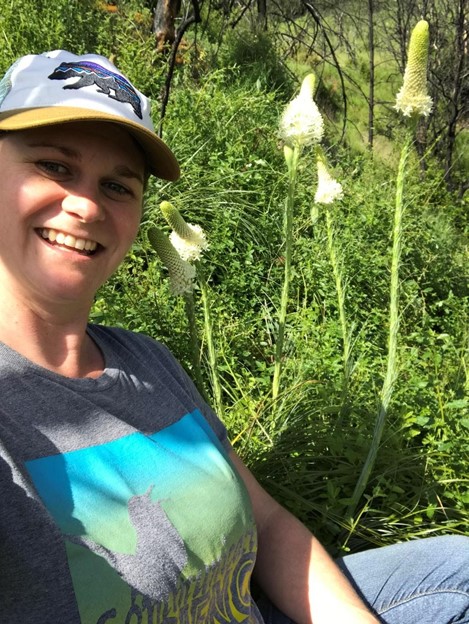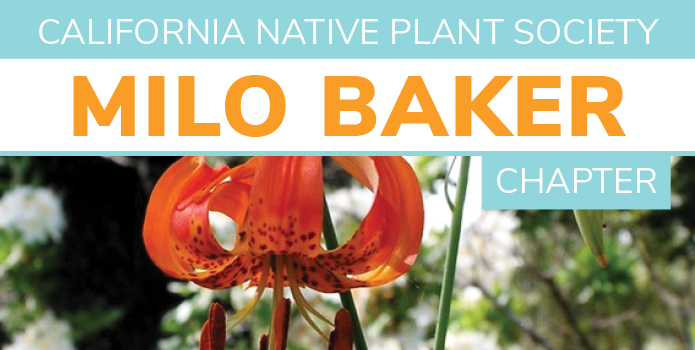In this issue: Speaker Series, Message From the President,
Darlene Lamont, Plant Sale, In the Summer Garden and Member Spotlight. |
September Speaker Series
|
Cynthia Powell- Executive Director of Calflora.org
Speaker Series, September, 2021 at 7:30pm via ZOOM
Link will be emailed day of event

Please join us to learn from Calflora’s Executive Director Cynthia Powell about new Calflora tools for CNPS native plant professionals, gardeners, and enthusiasts! Calflora aggregates millions of plant observations across the state from dozens of sources and serves them to the public free of charge. These data sources include CCH2 (a worldwide plant information portal from the California Consortium of Herbaria), iNaturalist, and CNPS plant checklists from around the state. How can you better use this incredible resource to learn more about regional plants?
At this presentation, Cynthia will cover Calflora’s planning your garden tool, specimen and other plant observations used in this tool, detailed plant ranges now available on Calflora’s species pages (for example, Grindelia stricta), population monitoring tools, and email alerts. She will also go over the important role CNPS members play in submitting and commenting on Calflora observations and checklists.
Cynthia Powell’s bio: After 3 years as Calflora’s GIS Project Manager, in 2016 Cynthia became Calflora’s Executive Director. She graduated with her MS in GIS (Geographic Information Science) in 2010 forecasting Mokelumne River water supply based on MODIS remote sensing snowpack images. She’s been examining what was under that snow — plants — ever since. She coordinates all Calflora programs, research, outreach, and advocacy, as well as fundraising and project management. Cynthia wears many hats, as shown by her photo above!
|
|
Speaker Calendar 2021
October: Saxon Holt, Photographer, Naturehood Gardening
November: Lorenzo Washington, Mycorrhiza and Plant Communities
|
|
Message from the Chapter President
As we usher in shorter days in September, much work is continuing on plans for the Milo Baker annual fall plant sale. The intention is to hold it in person at the Laguna Foundation property at 900 Sanford Road in Santa Rosa. Hopefully the health restrictions will allow this. If not, we will once more hold an online sale as there will be an abundance of beautiful plants to get in the ground.
We have made the difficult decision to continue to hold the Board meetings and members Speaker Series over Zoom again in September. While optimistic for future gatherings, we remain vigilant in protecting our members and the public. Please watch for email and view our Milo Baker website for updates on how to connect over Zoom or to call into the program.

(snowberry, Symphoicarpos. Photo: Wendy Smit)
There’s been good news on Walker Ridge in Lake County! This area is outside of Milo Baker chapter’s jurisdiction, but many of our members have walked these beautiful hills. It is a unique serpentine area, lovely in the late spring with annual wildflowers and bulbs. Our last field trip there was after a burn several years ago. It is located quite close to famed Bear Valley, another spot that hosts fields of flowers including the adobe lily, Fritillaria pluriflora. Congressman John Garamendi has introduced legislation in Washington to add the Lake County portion of Walker Ridge to the Berryessa Snow Mountain National Monument. CNPS staff in Sacramento have drafted a letter of support for this effort and have made it available to all CNPS chapters and members. If you are interested in sending a letter of support, please contact me or one of our Conservation Chairs.
Summer weather in Sonoma County, especially this dry year, makes for dormancy in many of our native plants. Yet, some continue to bloom. As you walk our local trails, note the tarweeds (Hemizonia) and rod wire lettuces (Stephanomeria) to name a few. Then, there are the beautiful berries and rose hips that light up the path and raise our spirits.
Wendy Smit,
Chapter President |
|
Darlene Lamont -- In Memory of a
Passionate and Resolute Naturalist
|
|

Walking with Darlene, one could not resist sharing her vision, her curiosity, her inexhaustible sense of wonder for and about the natural world. Her delight in the miraculous diversity of life extended to all corners of the world -- to forests, to mountains, to oceans, to the soil upon which we tread, and to the intrinsic value bestowed in every living organism. For all of us with whom she shared her gifts of observation and her skill in teaching, and for encouraging a deeper appreciation of the unity of life, we can best honor her legacy by keeping her passion for the wild – as well as her sense of human place -- in our hearts. May her humble reverence for Earth’s living miracles continue to shine as counterpoint to the tumult of humanity’s currently errant path.
Darlene Lamont moved on from this mortal plane of existence but several weeks ago, yet she will forever walk alongside as I seek the peace and solace of wild places. While I only shared nature outings and conversations with Darlene over the past ten years, we spontaneously and immediately shared our passion for the sanctity of life. She was a comrade in relishing the exhilarating joy of bird song and the delicate details of dragonflies, as well in expressing sorrow for humanity’s relentless ecological devastation. Darlene was on a constant quest for knowledge, for insights to promote her understanding, and provided me so any opportunities to learn – whether I was teaching her, or she was teaching me (more often than not!). Even as an ecologist, I always returned from the outings she led, or joined, having a new perspective on not just the plants and animals and fungi, but of myself as a bit player on the vast stage of the universe.
Darlene volunteered with many local organizations, among them Stewards of the Coast and Redwoods and Landpaths. She was a steward for a private reserve in her neighborhood and attended many local meetings on behalf of habitat for native plants and wildlife.
In her commitment to integrate her lifelong experiences into active conservation, Darlene was fearless in challenging authority, and resolute in resisting ego gratification and political expediency masquerading as environmental platitudes. Her persistence and diligence in demanding ecologically informed science as a basis for community projects, with loving support from her late husband, Jim, were inspirational. In paying homage to her resilience in the face of disappointment and heartbreak, I also acknowledge her passing as yet another reminder to live actively in one’s community, in this moment and every moment, and to defend the wild that nurtures our bodies, hearts, and souls.
As a teacher and advocate, Darlene contributed to local, regional, and global education efforts on behalf of plants, animals, fungi, and all the myriad living that comprise the fragile web of life. Her walks were workshops in whatever we encountered, and her website http://jimndar.net (Window on the World) provides ample testimony about her observations and contributions to ecological education.
Please join us in remembering Darlene with a modest gift for a picnic table in her name along the Sonoma Coast. Contributions can be mailed to: Betsy Livingstone, 9502 Argonne Way, Forestville, CA 95436.
-Peter Warner
This is the 50th annual plant sale for our chapter. What began as a modest sale at Old Court House Square in 1972, has become a huge sale with 2200 plants in our own Milo Baker Shade house! What an incredible feat for us.
The sale last year was held entirely online. I am very happy to say that this year the sale will be in person, at the Laguna shade house, 900 Sanford Road (off Occidental Rd.) Santa Rosa. Milo Baker Chapter members will get a chance to buy our plants on Friday night, October 8, at a pre-sale for members only. We have never done this before, so plan to take advantage of this offer. Refreshments will be served to celebrate the milestone 50th sale. Our flyer is included in this newsletter and features an illustration of the CA fuchsia by Alina Nuebel. This flyer advertises the pre-sale and celebration for our loyal members only. Therefore, do not post it on your local bulletin board. I have printed a flyer that excludes this information. If you would like one or more, give me a call
Betty Young, our nursery manager, and a group of faithful workers have been working non-stop to produce such a huge number of plants. Some were grown from seeds and others are from small plugs purchased from a wholesale nursery. Cal Flora Nursery helped us by letting us receive the plugs at the nursery.
In 1977, when I first joined the plant sale group, California was experiencing a drought and interest in CA native plants was just beginning. Now, when we are experiencing another drought, the interest in CA natives is at an all-time high.
We will have a better selection of plants than ever. The list of available plants is on our website—milobaker.cnps.org. A complete and final list will be posted on September 15. The plants will all be in gallon containers and will be priced at $10.00 each, including tax. We hope that this will make check out easy.
Another new thing at this year's sale will be green tags in all of the plants that are native to Sonoma County. Look for them if you want to grow plants that are from our special part of California.
Ceanothus (CA Lilac) is a very popular evergreen CA native that is drought tolerant and a vigorous grower. CA lilacs have blue flowers in the spring and only need occasional summer water. The large shrubs will be Ceanothus ‘Concha’(6’x6’), C. ‘Dark Star’(6’x6’) and C. ‘Skylark’(8’x8’). The groundcover C. gloriosus ‘Anchor Bay’ will create a dense mat 1 1/2 feet high and grow to 6 feet wide.
Arctostaphylos or manzanita are another group of drought tolerant CA native evergreen shrubs. The plants that we will offer include the slowly spreading ground cover A. uva ursi ‘Pt. Reyes’. It has glossy evergreen leaves and pinkish flowers followed by red berries. A. edmundsii ‘John Dourley’ (3’ x 6’) has a good tolerance for garden watering and blooms with pinkish flowers. A. pajaroensis has beautiful bronze new growth and will grow to 10’ x 6’.
Salvias are a genus that one can fall in love with. Most are part of the coastal sage scrub community. They are drought tolerant plants. Salvia mellifera, black sage, will form a 4’ mound 3’-5’ across. It has green leaves and white flowers. S. apiana, white sage, is a sun loving plant with white-grey leaves with long stems of white flowers in the spring. We will also have the compact form. Hummingbird sage, S. spathacea, is a creeper with tall (2’) flower stalks and bright pink flowers. The great groundcover, S. ‘Bee’s Bliss’ which is a cross between our Salvia sonomensis and S. apiana, will be available.
Hummingbirds love the Epilobium canum or CA fuchsia which is blooming now and is such an important flower for the fall garden. We will have 8 varieties for sale. Two have coral-colored flowers E. ‘Coral Canyon’ and E. ‘Sierra Salmon’. The rest will have the usual fiery red-orange flowers. They are E. ‘Calistoga’, ‘Cloverdale’, ‘Chaparral Silver’, ‘Everett’s Choice’, and ‘John Bixby’. Also, the very low growing E. septentrionalis ‘Select Mattole’.
A very good evergreen shrub for attracting pollinators is coffeeberry. Now called Frangula californica, formerly Rhamnus, it has a small cluster of green-yellow flowers followed by large red/black berries that animals will eat. We will be offering some that are grown from seeds as well as two popular cultivars, F. ‘Eve Case’ (7’ x’8’) and ‘Mound San Bruno’ (5’x 5’).
Other native shrub species that will be selling include Toyon, Heteromeles arbutifolia, the popular evergreen shrub with red berries at Christmas time. Baccharis pilularis, coyote bush, was grown from seeds and will be either a male or female plant and will grow to 6’ to 8’ tall and wide. Good for revegetation projects. There will also be the cultivar Baccharis ‘Twin Peaks’, it is a dwarf, male plant (no messy fluffy flowers) and will grow to 3’ and spread to 6’ in a few years. Give them both some summer water for the best look. Calycanthus occidentalis, CA spicebush, is native to our stream sides. It has very unusual brownish-red flowers followed by equally unusual seed pods. It is a deciduous shrub to 10’. Gambelia (formerly Galvezia) speciosa ‘Firecracker’ is a smaller form of Island Snapdragon. It has the same red flowers on the tips of the arching branches.
Eriogonum, wild buckwheat, and Mimulus and Diplacus, the monkeyflowers, I consider to be sub-shrubs. They are woody and drought tolerant and rather small to 3’ or so. The flowers of the wild buckwheats attract a lot of small pollinators, native bees especially. E. nudum has low growing leaves with an attractive silvery underside; it sends up a 3’ flower in stalks of white flowers in the late summer. A groundcover buckwheat that is flowering now is E. fasciculatum ‘Warriner Lytle’. The pink-flowering buckwheat, E. grande rubescens, is a charmer that re-seeds readily. It has a mound of felty grey leaves and sends up a flowering stalk that is about 15” tall and topped with a cluster of small pink flowers. E. arborescens, Santa Cruz Island Buckwheat, will grow to 4’ x 4’, has attractive reddish bark and long-stalked flat clusters of pale pink flowers in late spring.
The monkeyflowers that we will have been Diplacus aurantiacus, the golden flowered plant that we see growing on our hillsides, is very drought tolerant and lovely in a garden setting where it gets a little water to keep it green in the late summer. The same is true of the other two species that we will be offering: D. linearis and D. grandiflorus (Azalea flowered).
The Mimulus that we have will be M. ‘Changling’, ‘Eleanor’, and ‘Vibrant Red’. Their growth habit is very similar to the Diplacus mentioned above. I am so confused about the names of the monkeyflowers, as their taxonomy has been undergoing changes, so don’t ask me to clarify.
There will be lots of perennials: Penstemon heterophyllus ‘Margarita BOP’ and ‘Blue Springs’ as well as a new one P. pseudospectabilis, all with blue flowers. Two Phacelias, P. bolanderi and P. californica, both very garden worthy. P. bolanderi is a spreading groundcover with lots of small lavender flowers.
An exciting new Monardella, coyote mint, with unusual orange flowers is M. macrantha ‘Marian Sampson’. It is a rather sprawling plant to 6” tall, but the flowers are a spectacular cluster that is 1 1/2 inches long. The ever-popular M. villosa ‘Russian River’ is a small bush with grey-green leaves and small heads of lavender flowers. There will also be Heuchera maxima and H. micrantha, also called alum roots. The CA alum roots have been crossed with coral bells and we will offer the Heuchera ‘Canyon Duet’ which will have lovely pink flowers. Other perennials are Aster chilense (low growing, spreading) and a Keckiella cordifolia (a type of Penstemon).
Verbena lilacina ‘De La Mina’ is a long flowering, low growing mound 1-2’ tall x 2-3’ wide with lavender blossoms for a long period. Many members have grown this in their garden and love it. Another Verbena that we will offer is Verbena ‘Paseo Rancho’. It is so new that I wasn’t able to find any information about it. Worth a try.
As always, we will have a good selection of native ferns, including for the first-time wood fern, Dryopteris arguta, that Wendy Born grew from plugs provided by Casa Flora, a nursery in Texas. Wood fern fronds persist through the summer with little water. It is a good companion with Polystichum munitum, sword fern, another woodland fern that is green through the summer and requires infrequent watering. Another new offering will be the Polypodium californium v. Lyman. This is an unusual polypody with pinnae that are incised along the margins, very attractive. Like all Polypodys, it is summer dormant, with fronds that emerge in the fall. Ferns that require constant moisture are Adiantum aleuticum, five finger fern, and Adiantum X Tracy’s which is a cross between the five-finger fern and our northern maidenhair.
Butterfly plants that we will have been the milkweeds that are the food for the caterpillars of the Monarch butterflies. We will have both species that grow in Sonoma County—Asclepias fascicularis, narrow-leaved milkweed and A. speciosa, showy milkweed. Another butterfly plant is the Dutchman’s pipe, Aristolochia californica. It is a vining plant that the Pipevine Swallowtail lays its eggs on. The caterpillars eat the leaves exclusively. Plant it and they will come.
I have tried to give you an overview of the plants at the sale so that you can begin to plan. I included most of the plants that we have more than ten. Check the website on September 15 for the final list.
The plant sale is the only fundraiser that the Milo Baker Chapter holds every year. We have built a new facility to ensure that the plants that we sell will not be infected with the root rot Phytophthera. Please be sure to walk through the disinfectant mat when you enter the nursery and respect all the protocols to ensure that the nursery remains a clean space.
Fall is planting season in California. The soil is still warm, and the roots will grow through the rainy season and will be well rooted in the spring, ready to survive the summer heat.
See you at the plant sale.
Liz Parsons
Vice President
|
With the drought and high temperatures of August I know we are all chomping at the bit to get to Fall planting. Personally, I have a very sad and dry garden this year- but the native plants are still alive with weekly watering - gotta feed those pollinators and birds! Cooler temperatures are coming, and our Fall sale is perfect timing to get these wonderful plants in the ground.
I’ve pulled a few of my favorite combinations together for your enjoyment.
Sun:
Arctostaphylos ‘Dr Hurd’ (Dr Hurd Manzanita), Salvia ‘Winnifred Gillman’ (Winnifred Gillman’s Sage), Ceanothus spp. (California Lilac - anyone will do!), and Muhlenbergia rigens (Deer Grass)
This combination fits most areas in Sonoma County and can be quite stunning as a hedgerow on a mound.
Create a perennial meadow:
Diplacus aurantiacus (Sticky Monkeyflower), Festuca californica (California Fescue) - use this large grass on edges, Stipa pulchra (Purple Needlegrass), Achillea millefolium (Yarrow) and Symphyotrichum chilensis (California Aster - really could they make the simplest botanic name harder to remember!? Or is it just me). Perennial meadows are a bit tricky to create so I fake it with this mix. I usually add some groupings of Frangula californica ‘Mound San Bruno’ (Mound San Bruno Coffeeberry).
Part Sun to Shade:
Calycanthus occidentalis (Spice Bush), Salvia spathacea (Hummingbird Sage), Iris douglasiana (Douglas’s Iris), Rosa californica (California Rose), and Heuchera micrantha (Alum Root). Mix in a groundcover of Clinopodium douglasii (Yerba Buena). Shoot for at least three of each plant in a larger space. For a small garden one spice bush will do - they are pretty big.
I will be on hand both days at the plant sale if you need help. Too many wonderful plants to choose from - these are just my easy go-to’s! I’ll try to draw up a couple of plans for the website.
Enjoy!
April Owens
Horticulture Chair
 
In the sea of straw mulch that is my backyard (normally vegetable garden), there is one fabulous, thriving thing: Symphyotrichum chilense "Purple Haze," which has gotten almost no water this summer. Outside the fence, in the most inhospitable of locations for heat and little water, there is a second bloom on the Salvia microphylla "Mesa Azure" and of course, the delightfully flaming Epilobium septentrionale "Select Mattole." The bees and hummingbirds are hanging out, enjoying it all.
Karen Thomson
CNPS Milo Baker Treasurer
Send us some pictures and notes about your garden waking up or going dormant in the heat of September. We’d love to share your stories.
|
Member Spotlight: Michelle Halbur
|
|

What is your current role in the CNPS Milo Baker chapter?
Michelle Halbur recently joined the CNPS Milo Baker Chapter Board in January 2021 and has been a member since 2004. She has presented to the chapter on a few occasions about her work as the Preserve Ecologist at Pepperwood Preserve as well as her graduate research on Sebastopol meadowfoam.
What is your favorite memory associated with CNPS Milo Baker?
It’s hard to pick a favorite, but a more recent pre-pandemic memory was joining members at the restaurant Kirin before I gave a presentation to the chapter on the Tubbs Fire impacts at Pepperwood Preserve. I felt so welcome at that table and immensely enjoyed the company of the plant enthusiasts and friends present. As I’m sure many of you do, I yearn for the carefree Covid-free days of dining and conversing with friends, making this memory even sweeter.
What do you do when you’re not enjoying California native plants?
Explore the wonders of life and nature with my young kids ages 3 and 6, get my hands dirty in the garden, express my creativity in cooking, attempt to read whenever I have a few moments, and try desperately to keep up with all the household chores and maintenance!
What is your favorite place to go to look at California native plants in Sonoma County?
Everywhere I go I am looking for native plants! I am so fortunate to be able to walk throughout the diverse hills of Pepperwood Preserve and my favorite places are the ones I say hello to every year and the ones that surprise me – around the bend, over the hill, along a roadcut, or a different way than I usually go. A real treat is exploring gems of native communities associated with different soils or hydrology, such as serpentine or vernal pools. How can anyone pick a favorite when this county is full of so many gorgeous nooks and crannies?!
What’s your favorite CA native plant?
Anything with blue – be they petals (e.g., Delphinium) or pollen (e.g., Gilia). Blue is a rare color in nature and the way plants change their chemistry, like altering the acidity of red anthocyanin pigments, to reflect blue light is fascinating.
Why are California native plants important to you?
Native plants are important to me because they are important for all living beings.
Volunteer Opportunities
Sonoma County Living Learning Landscapes first Friday of the month at 10am meet 1808 Albany Drive Santa Rosa email or call April Owens 707.331.2070 aprilleeowens@gmail.com.
Bring: hand pruners if you have them and a mask of course.
Invasive Ice Plant Removal Wednesdays 9:30-11:30 at Doran Beach. Text Invasive Plant Chair Jan 707.569.4724 to find out where they are working let her know you are coming!
|
|


